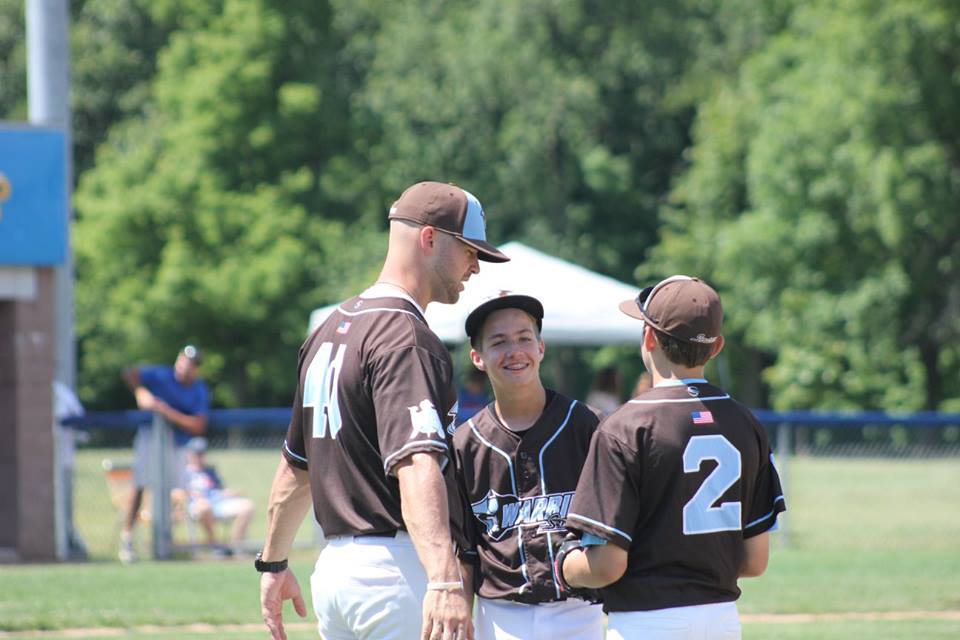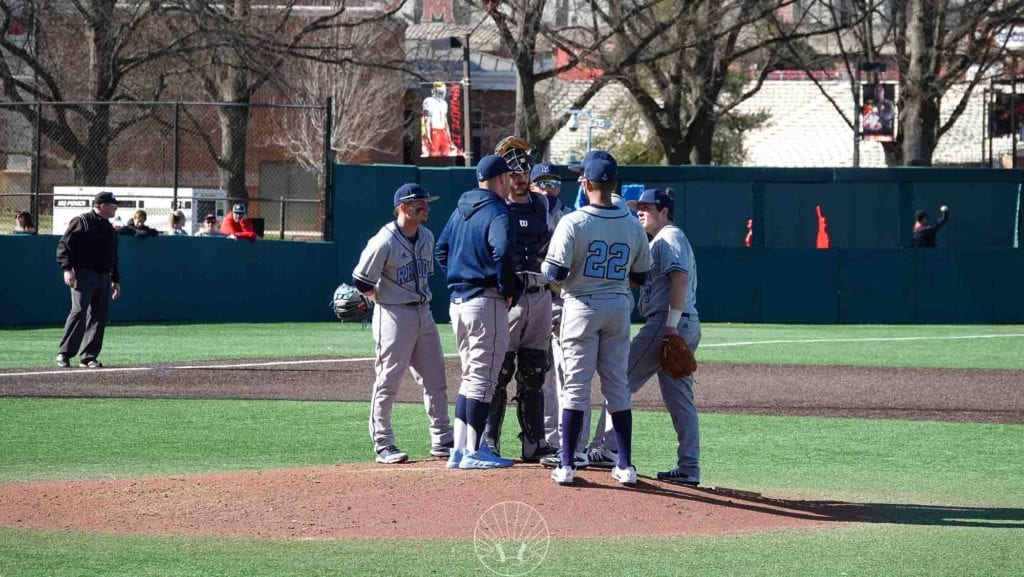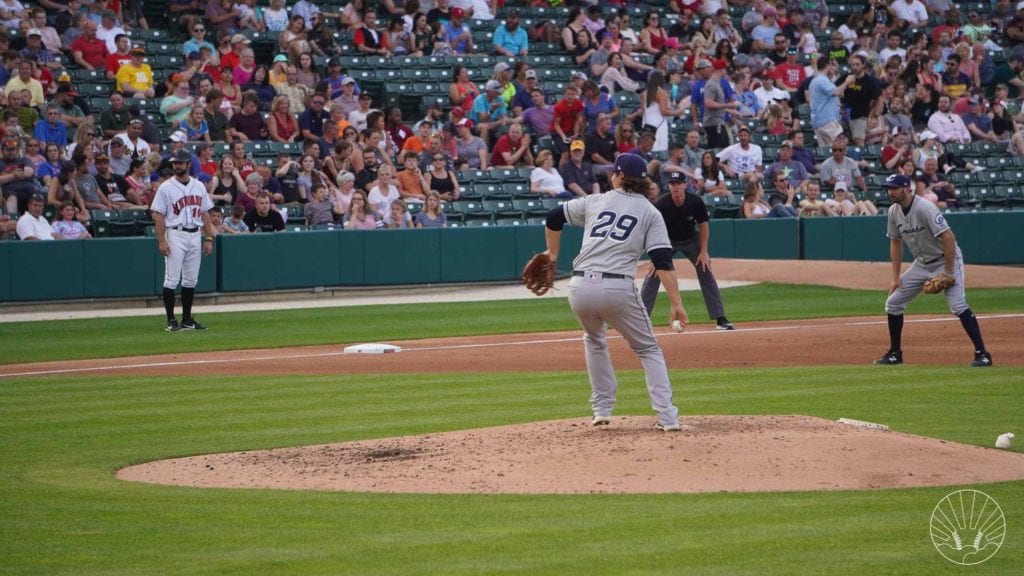*This article may contain product links which pay me a small commission if you make a purchase. Learn more.
What should a coach say to a pitcher in a mound visit? During my playing days, I had some good visits and some worthless ones, and my parents always wanted to know what were the magic words my coach had to impart.
Now, as a coach myself, I’m the one giving advice in these fleeting in-game therapy sessions. But, what is best to say to a pitcher when he’s struggling? What helps, and what doesn’t?
Let’s discuss: What goes on in a mound visit?
First: Why Do We Have Mound Visits?
There’s really only one reason: To increase the performance of the pitcher. But, in doing that, we visit when we see performance start to slip, or to preemptively strike before a downhill slide.
A Few Good Reasons to Visit:
- Give a pitcher a breather in the midst of a long inning. This helps break bad momentum and give him a physical and mental reprieve. Especially if it’s hot and humid, a simple breather helps.
- Get a pitcher mechanically back on track. Young pitchers are especially susceptible to rushing and flying open with their front side, and they don’t make adjustments well. Mound visits provide a quick reminder to get them back in the strike zone.
- Gauge fatigue and mental state. If a pitcher looks tired or shows negative body language, it’s worthwhile to take a visit to see what’s going on with them.
- Discuss tactics and situations. When the game is on the line, or there is high-leverage situation (runners on 2nd & 3rd with two outs, for example), a visit is useful to remind them of the hitter’s tendencies, the situation, the required mindset, and how we might want to approach this at-bat.
- Calm him down. After a string of bad calls, errors, cheap hits, or whatever, it may be a good time to simply take a moment to pick the pitcher up mentally and remind him that he’s doing HIS job, before he loses confidence.
Are there more reasons than this? Sure – we can delay the game to allow a reliever to get extra warm ups, talk defensive positioning with the infielders if necessary, etc. etc. But, for the purposes of this article, we’re talking more about what specifically pertains to helping the pitcher.
Want to Learn More About Coaching Pitchers?
Enroll in my Free Email Course Built Specifically For Youth Coaches and Parents.
What’s In a Bad Visit?
- Negativity. The goal of a visit is to increase the performance of your pitcher. When I see coaches go out and yell at their pitcher or the fielders, that’s a coach who doesn’t understand the game or human motivation in general. Berating a pitcher for leaving balls down the middle, or for walking guys isn’t helping anything.
- Threats. If a pitcher is struggling, threatening to pull him will only make him more tense and timid with the strike zone – he’ll be more likely to guide the ball and fear missing.
- Cheerleading. Just being a hype man isn’t enough, either. Positivity is great, but it needs to come with a real and actionable message about why and how the pitcher should feel that he’ still in control. Telling a pitcher he’s doing a good job when he isn’t, or when he’s falling apart mechanically, doesn’t help the cause.
- Complex escape plans. When a pitcher struggles, he needs something simple that he can do right away to get better results. Talking too much strategy can overwhelm a young pitcher who isn’t ready for that.
What’s In A Good Visit?
A Simple, Actionable Fix
During a game, the root cause of most young pitchers’ mechanical struggles stem from rushing and/or flying open on the front side.
If he’s rushing, I tell him to move a little slower to the plate and to stay on his back leg a little longer; collect himself, then make the pitch.
If he flies open, I ask him to see his front shoulder in the corner of his eye as long as he can.
Neither of those two gems of advice are complicated or state-of-the-art. But, they’re good, simple fixes that a pitcher can understand and act upon on the next pitch.
You can’t give overly complex advice (your hips are opening up too soon; your back leg is collapsing; your stride line is off) because it will derail a pitcher even more because of the mental energy he’ll have to spend trying to fix his mechanics as he tries to make quality pitches.
An Explanation of Why You’re Out There.
When I was younger, I felt like I was in trouble and in danger of getting pulled when I’d get a mound visit. I haven’t felt that way in a long time, because I started to view mound visits as a “team strategy event” more so than “Uh oh…I need to get it together or I’m done.”
I always liked when my pitching coach would state the purpose of his visit right away. “Hey Blew, I’m just here to give you a breather, and remind you that this guy at the plate loves first pitch breaking balls.” Then, we’d talk, take care of business, and he’d be on his way. When a visit was done this way, it reminded me that my coach was part of the team there to help, not the boss coming to scold me. I’d often start my own visits:
“Hey John, you still look strong out there, let’s just talk about this situation real quick…”
A Reminder of Why He’s Out There.
This is where positivity comes in. I like to remind my pitchers why they’re good and what they’re good at. Remind him that he’s still the guy we want out there because of X, Y and Z; that gets the back in the mindset they have when they’re pitching well.
Remind them of their strengths, remind them that those strengths are still there, and then tell them how to use their strengths to get out of the inning.
A Reminder of the Situation

Young players have no clue how to situationally pitch, so any time there is a good teaching moment, it’s valuable to get out there and remind them, so they can see the game the same way you do.
Bases loaded and no one out: a pitcher needs to be reminded that he gets himself out of such a jam by throwing strikes. It’s scary, but it’s the #1 thing he has to do. Get ahead, get a ground ball or get to two strikes. If you get to two strikes and you’re ahead, try to punch him out. If you get that first punch out, now you’re a ground ball away. Explain to the pitcher how he can get himself out: Pop up and a double play ball. Ground balls. Strike one, then move the ball to the corners. Whatever it is, situational talks are crucial.
Pitchers also need to be reminded when a hitter cannot score. 2nd and 3rd with two outs is a cannot score situation, because there is a base open. The base open means that the pitcher does not have to pitch to the white of the plate, and he can pitch backwards in even counts or if he falls behind, because walking the hitter doesn’t hurt him nearly as much as a cookie right down the middle of the plate.
So, we talk about these situations and remind the pitcher and catcher that we need to think extra hard before choosing each pitch.
Something To Get The Fight Back

Pitchers get blown up when they let things snow ball – they walk a guy, then get timid and walk two more. They give up a hit, then start nibbling then walk the next. The give up two hits, then get frustrated and overthrow, allowing two more.
I always liked it when my pitching coach would remind me that the hitter I was facing couldn’t hit me, that he stunk in general, or that the team I was facing was beneath me. It gave me a boost and put me back into attack mode.
So, I like to throw digs at the other team into the mix. Remind my pitcher that he’s great, and that the guy at the plate is a joke, and that the inning is already over.
Reminder That You’re On His Side
Pitchers need to be defended against bad umpiring, bad fielding and bad luck. It’s easy to get discouraged out there when you feel like you made good pitches that got called balls, when you worked hard for ground balls that got booted, or that good pitches became bloop singles.
The job isn’t about running out and pointing fingers, but rather just reminding the pitcher that he’s done his job, and that luck is a part of the game (which it absolutely is). Batting average on balls in play (the amount of batted balls that become hits, excluding walks, strikeouts and home runs) hovers at about .300 in the MLB, and even higher at younger levels of baseball where fielding is poor and fielders have diminished range. That means for most amateur pitchers, 4 out of 10 batted balls will become hits, no matter how well he locates and “does his job.”
So, sometimes it’s valuable as a coach to argue with the umpire for the sake of reminding the pitcher that you’ve got his back, that you feel the same way he does. And, reminding him on the mound that he did, in fact, make good pitches and got poorly rewarded for it, and that he doesn’t have to change anything.
Some Memorable Examples
There are examples of what to do, and what not do, from various points in my playing career. Here are a few that illustrate the above.
Cheerleading
I was 19 or 20, and pitching in relief against Towson University. I walked a few batters, and everything was up in the zone. My coach came out, and was very positive:
Hey Dan, your mechanics look GREAT. Your velocity is GREAT. You look really strong on the mound right now.
That was all that was really said. What happened? I continued walking hitters and made no adjustment whatsoever.
It was really great to hear words of encouragement, but it didn’t help me fix what was wrong. I got yanked the next inning.
Something to Get The Fight Back
In 2012, I was pitching in for Evansville, on the road in Michigan. We had lost four straight games and I had a 3-1 lead with two outs in the 8th. I had two runners on (second and third, if my memory is correct) and my pitching coach came out.
Hey Blew. Well, we have our closer over there warming up (he turns to the bullpen, getting me to look over). I’m thinking we’ll bring him in right here. What do you think about that?
I looked at him. I knew quite well that coaches don’t ask your opinion on moves, and he was waiting for a reply.
He can’t hit a breaking ball. I have the best curveball on this team. Leave me in.
He looked at me, smirked, then said, “Okay. That’s all I needed to know.” Then he walked back to the dugout.
I knew what he did – it was obvious and I saw right through it – he was testing my confidence and wanted to hear me say what he already knew I would say. But, it worked, and that visit sticks with me.
I struck that hitter out on four pitches.
“Other”
I was 19 and playing summer ball for a team in the Washington, D.C. area. I was playing for a coach named Bobby who reached Triple-A with the Yankees as a player and who was a well-respected pitching mind. I was intimidated playing for him and didn’t say much, since I didn’t know much.

But, I was always tinkering, trying to find ways to improve myself, especially in summer ball where stakes weren’t high. It was a good league, but it was still summer ball.
In one of my starts I felt like I was too hyped-up and too aggressive. I also knew that my hardest velocities also came on 2-0 and 3-0 fastballs; when I loosened up, I tended to throw harder. So, the next time out, I was tinkering with trying to pitch as relaxed as I could. Apparently, somewhere in this start I yawned. Innocent, accidental by-product of what I was trying to do. I got a visit in the middle of an inning when I wasn’t struggling, and I wasn’t sure why Bobby was coming out to talk to me.
It was a very brief visit…
If you ever [expletive] yawn on my mound again, you’ll never throw another [expletive] pitch for me.
That was all that was said. He turned and walked back to the dugout. I gulped, and stopped trying to be so relaxed.
But, I learned a big lesson that day about respecting the game, even if I didn’t know I was disrespecting it. I’m big on playing the game the right way, and I try to instill in young players just how important professionalism is. I think much of that started because of that quick mound visit. We’ll call that the “Other” category.
Learn How to Be a Great Pitching Coach in My Free Course

In this free course you’ll learn:
- Pitch count guidelines and how to safely utilize pitchers
- The best terminology to get relievers ready to enter a game
- What you’re doing wrong when preparing pitchers to start a game
- How to structure a great pregame routine
- More Strategies for having productive mound visits
- Much more!
Sign up Today – It’s Free and You’ll Learn a Ton
Thanks for reading and let me know if this article on mound visits spoke to you! – Dan Blewett
